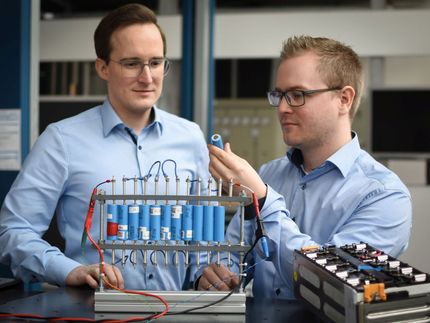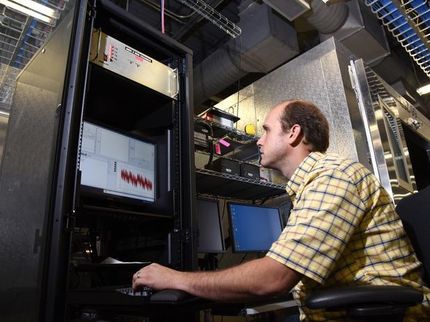Mini flow battery speeds energy storage research
Tiny flow battery delivers outsized benefits, reducing time, cost, and resources needed for testing new battery materials
Sometimes, in order to go big, you first have to go small. That’s what researchers at the Department of Energy’s Pacific Northwest National Laboratory have done with their latest innovation in energy storage.

PNNL flow battery researcher Ruozhu Feng handles a standard lab-scale flow battery device.
Andrea Starr | Pacific Northwest National Laboratory
With a goal to speed the time to discovery of new grid energy storage technology, the team designed a compact, high-efficiency flow battery test system that requires an order of magnitude less starting material while delivering results equal to the standard lab-scale test systems. The new mini flow cell design and experimental validation is described in an article published in the Journal of The Electrochemical Society. The redesigned mini flow cell closely mimics the internal structure of a traditional flow cell, scaled down by a factor of 5. But, despite its smaller size, the mini flow cell exhibits comparable performance to its larger counterpart.
Mini flow battery delivers big results
“This report is the first step, showing that scaling down our experimental system works,” said materials scientist and flow battery researcher Ruozhu Feng, a lead author of the study. “Our ultimate goal is to bring the power of AI and robotics into this process to automate and accelerate the testing of new flow battery designs.”
By reducing the amount of material needed and speeding up the validation process, this technology could help advance renewable energy solutions. Researchers also believe this miniaturized approach will facilitate experimentation with a broader range of experimental chemistries.
“Currently, we have to prepare a lot of material when we identify a promising new battery formula, and this takes a lot of time,” Feng said. “With this mini flow cell process, we can figure out whether a proposed new material works with only a tiny amount—milligrams—available.”
The mini flow cell design is geared toward research laboratories that are focused on rapid screening and development of new battery materials. In their research study, the team showed that the new mini flow cell is suitable for rapid validation of material stability. Rigorous testing over a wide range of material chemistries and concentrations helped boost researchers’ confidence in the new scaled-down system. However, the team does note that it requires highly purified starting materials that are free from impurities that could otherwise clog the narrow channels and tubes.
The research team has applied for U.S. patent protection for their new battery design. To learn more about collaboration or licensing opportunities related to the new technology, contact our commercialization team.
A team effort
The key to their success, according to lead researcher and designer of the mini flow cell, Soowhan Kim, was that the team has over a decade of experience in flow battery cell design, along with engineering, skilled machining, and chemistry experience. For example, PNNL instrumentation and systems control expert Andrey Liyu used his mechanical engineering and microfluidics experience to complete the scale down without sacrificing accuracy.
“From small cells to big stacks, we can handle all scales of flow battery design and experimentation,” said Kim, a lead research at PNNL’s Grid Storage Launchpad. “When we add the computational expertise and analytical chemistry experience, this is how we combined efforts to develop the mini flow cell. Our hope is to make this available to all researchers who are interested in using it.”
What is a flow battery?
As their name suggests, flow batteries consist of two chambers, each filled with a different liquid. The batteries charge through an electrochemical reaction and store energy in chemical bonds. When connected to an external circuit, they release that energy, which can power electrical devices. Flow batteries are a linchpin technology—they store energy from intermittent energy sources such as wind and hydroelectric power, and then release that energy on demand for grid-scale applications. Unlike traditional batteries, flow batteries use liquid electrolytes stored in external tanks, providing flexible scaling of energy capacity.
Why are new flow battery designs needed?
To make flow battery systems practical for large-scale use, researchers are seeking new chemical and material combinations that address limitations of existing systems. Some of these limitations include high material costs, low power density and the desire to source materials domestically in the United States.
How are new flow batteries discovered?
Traditionally, discovery of new materials for flow batteries has been a laborious trial-and-error process, often requiring gram-scale synthesis of organic compounds, extensive testing, and significant time investment. This new miniaturized cell design, about the size of a playing card, uses the equivalent of a few grains of sand, drastically reducing the time and resources required for each test while still delivering reliable results.
Original publication
Other news from the department science
These products might interest you
Most read news
More news from our other portals
See the theme worlds for related content
Topic World Battery Technology
The topic world Battery Technology combines relevant knowledge in a unique way. Here you will find everything about suppliers and their products, webinars, white papers, catalogs and brochures.

Topic World Battery Technology
The topic world Battery Technology combines relevant knowledge in a unique way. Here you will find everything about suppliers and their products, webinars, white papers, catalogs and brochures.































































